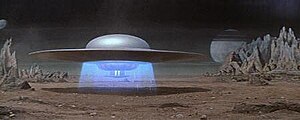
Forbidden Planet is a 1956 American science fiction film from Metro-Goldwyn-Mayer, produced by Nicholas Nayfack, and directed by Fred M. Wilcox from a script by Cyril Hume that was based on an original film story by Allen Adler and Irving Block. It stars Walter Pidgeon, Anne Francis, and Leslie Nielsen. Shot in Eastmancolor and CinemaScope, it is considered one of the great science fiction films of the 1950s, a precursor of contemporary science fiction cinema. The characters and isolated setting have been compared to those in William Shakespeare's The Tempest, and the plot contains certain happenings analogous to the play, leading many to consider it a loose adaptation.

Robby the Robot is a fictional character and science fiction icon who first appeared in the 1956 film Forbidden Planet. He made a number of subsequent appearances in science fiction films and television programs, which has given him the distinction as "the hardest working robot in Hollywood".

A scale model is a physical model which is geometrically similar to an object. Scale models are generally smaller than large prototypes such as vehicles, buildings, or people; but may be larger than small prototypes such as anatomical structures or subatomic particles. Models built to the same scale as the prototype are called mockups.
The Krell are a fictional extinct technologically-advanced alien species from the 1956 science fiction film Forbidden Planet. The first human starship to land on the Krells' home planet of Altair IV, the Bellerophon, was destroyed, with the only survivors being Dr. Edward Morbius along with his wife and daughter. In his isolation, Morbius became the lone researcher to ever study the extinct Krell.
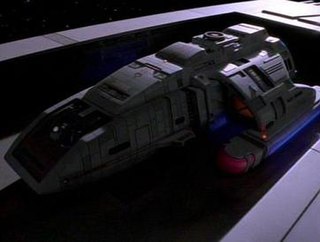
Runabouts are a fictional class of small, multi-purpose starships appearing in the Star Trek science-fiction franchise, primarily the television series Star Trek: Deep Space Nine, which aired on syndicated television between 1993 and 1999. They served as a means of transport for the crew of the fictional space station Deep Space Nine, in the early seasons of the series enabling storylines taking place away from the station.
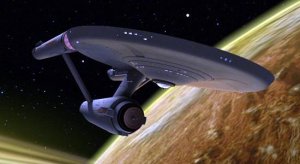
USS Enterprise (NCC-1701) is a starship in the Star Trek media franchise. It is the main setting of the original Star Trek television series (1966–69), and it is depicted in films, other television series, spin-off fiction, products, and fan-created media. Under the command of Captain James T. Kirk, the Enterprise carries its crew on a mission "to explore strange, new worlds; to seek out new life and new civilizations; to boldly go where no man has gone before." Star Trek: Strange New Worlds (2022–23) depicts the Enterprise under the command of Kirk's predecessor, Captain Christopher Pike.

USS Enterprise (NCC-1701-D), or Enterprise-D, is a starship in the Star Trek media franchise. Under the command of Captain Jean-Luc Picard, it is the main setting of Star Trek: The Next Generation (1987–1994) and the film Star Trek Generations (1994). It has also been depicted in various spinoffs, films, books, and licensed products.

A dollhouse or doll's house is a toy house made in miniature. Since the early 20th century dollhouses have primarily been the domain of children, but their collection and crafting is also a hobby for many adults. English-speakers in North America commonly use the term dollhouse, but in the United Kingdom and other English-speaking countries the term is doll's house. They are often built to put dolls in.
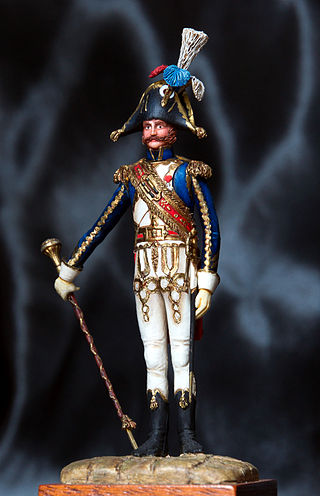
A model figure is a scale model representing a human, monster or other creature. Human figures may be either a generic figure of a type, a historical personage, or a fictional character.
Shuttlecraft are fictional vehicles in the Star Trek science fiction franchise built for short trips in space, such as between a planetary surface and orbit. Also referred to as shuttles, their introduction preceded the development of the Space Shuttle.
"The Little People" is episode 93 of the American television anthology series The Twilight Zone. It originally aired on March 30, 1962 on CBS.
1:144 scale is a scale used for some scale models such as micro/mini armor. 1:144 means that the dimensions of the model are 1/144 (0.00694) the dimensions of the original life-sized object; this equates to a scale of 1/2 inch per 6 feet of original dimension. For instance, an airplane 30 feet (9.14 m) in length would be a mere 2.5 inches (63.5 mm) long as a 1:144 scale model.

1:32 scale is a traditional scale for models and miniatures, in which one unit on the model represents 32 units on the actual object. It is also known as "three-eighths scale", since 3⁄8 inch represents a foot. A 6 ft (183 cm) tall person is modeled as 2+1⁄4 in (57 mm) tall in 1:32 scale.
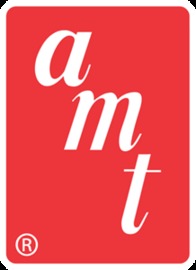
Aluminum Model Toys (AMT) is an American brand of scale model vehicles. The former manufacturing company was founded in Troy, Michigan, in 1948 by West Gallogly Sr. AMT became known for producing 1:25 scale plastic automobile dealer promotional model cars and friction motor models, and pioneered the annual 3-in-1 model kit buildable in stock, custom, or hot-rod versions. The company made a two-way deal in 1966 with Desilu Productions to produce a line of Star Trek models and to produce a 3/4 scale exterior and interior filming set of the Galileo shuttlecraft. It was also known for producing model trucks and movie and TV vehicles.
1:72 scale is a scale used for scale models, most commonly model aircraft, where one inch on the model equals six feet in real life. The scale is popular for aircraft because sizes ranging from small fighters to large bombers are all reasonably manageable and displayable.

The Aurora Plastics Corporation was an American toy and hobby manufacturing company. It is known primarily for its production of plastic scale models of cars, airplanes, and TV and movie figures in the 1960s. Its principal competition in modeling were various other plastic modeling firms like Revell and Monogram.

Holiday lighting technology has been subject to considerable development and variation since the replacement of candles by electric lights. While originally used during the Christmas holidays as Christmas lights, modern electric light arrays have become popular around the world in many cultures and are used both during religious festivals and for other purposes unconnected to any festivities.

The Millennium Falcon is a fictional starship in the Star Wars franchise. Designed by Joe Johnston for the movie Star Wars (1977), it has subsequently appeared in The Star Wars Holiday Special (1978), The Empire Strikes Back (1980), Return of the Jedi (1983), The Force Awakens (2015), The Last Jedi (2017), Solo: A Star Wars Story (2018), and The Rise of Skywalker (2019). Additionally, the Falcon appears in a variety of Star Wars spin-off works, including books, comics, and games; James Luceno's novel Millennium Falcon focuses on the titular ship. It also appears in the 2014 animated film The Lego Movie in Lego form.

Galileo is a fictional spacecraft that appeared in the 1960s American science-fiction television series Star Trek. It was a shuttlecraft assigned to the USS Enterprise, and was the first of its type to be seen on screen in the franchise, appearing in the episode "The Galileo Seven". It appeared an additional four times in the series before being replaced by the Galileo II, a repaint of the full-size exterior model.
